Preveli Beach Crete: Complete Guide to the Palm Tree Paradise
Discover everything you need to know about Crete's unique palm beach - how to get there, the palm forest, river hike, best swimming spots, and insider tips
Preveli Beach: Crete's Exotic Palm Forest Oasis
Nestled on the southern coast of Crete, Preveli Beach is one of the island's most extraordinary natural wonders. Where a freshwater river meets the Libyan Sea, a lush palm forest flourishes, creating a tropical paradise unlike anywhere else in Europe. This comprehensive guide covers everything you need to know about visiting this unique destination – from detailed driving directions and hiking paths to the best swimming spots and nearby attractions. Whether you're planning a day trip from Rethymno or including Preveli in your extended Crete itinerary, this guide will help you make the most of your visit to one of Crete's most photogenic and ecologically fascinating beaches.
Contents
About Preveli Beach
Preveli Beach, also known as Palm Beach or Phoenix Beach, is a unique coastal destination where the Kourtaliotiko Gorge meets the Libyan Sea, creating one of Crete's most distinctive landscapes. What makes Preveli truly spectacular is the palm forest (Phoenix theophrasti) that thrives along the banks of the freshwater river as it flows into the sea.
This rare combination of features – a sandy beach, crystal-clear seawater, a freshwater river with small waterfalls and pools, and a lush palm grove – creates an almost tropical paradise that feels more like something you'd find in the Caribbean than in Europe. The towering cliffs that surround the beach add drama to the landscape and frame the exotic scenery.
The name "Preveli" comes from the historic Preveli Monastery located nearby, which played a significant role in Cretan history, particularly during World War II when it sheltered Allied soldiers. The beach and surrounding area hold cultural significance beyond their natural beauty.
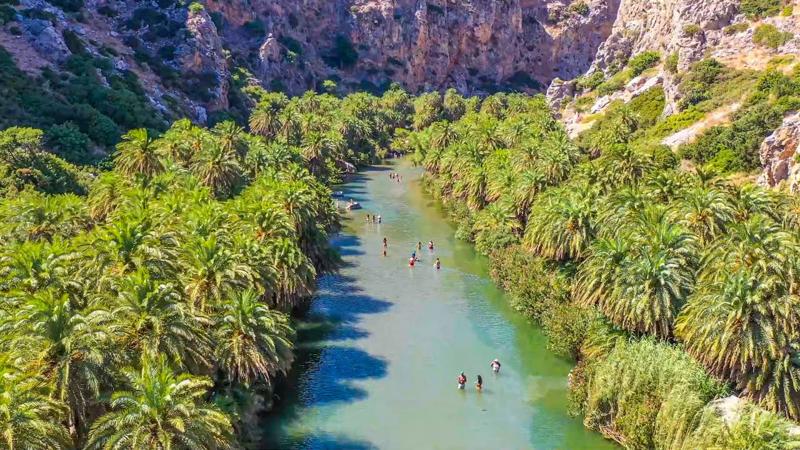
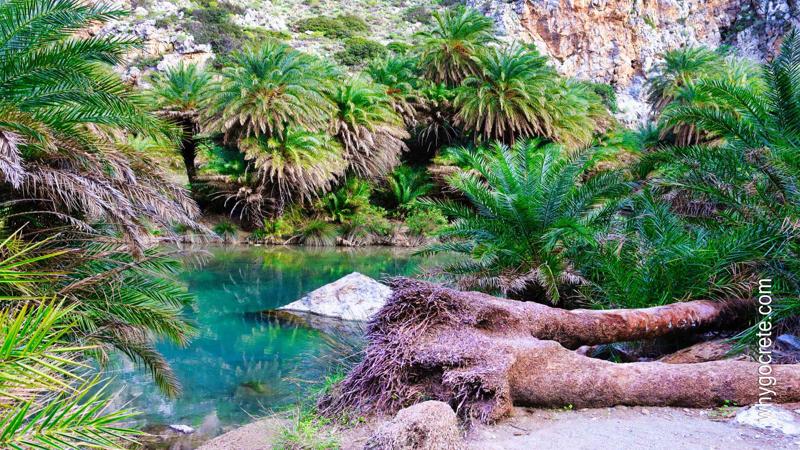
Geological Features
Preveli's landscape has been shaped over millennia by the Kourtaliotiko River (also called the Megalopotamos River) carving its way through the rock, creating a gorge that eventually opens up near the sea. The river, which flows year-round, has formed small lagoons, waterfalls, and swimming holes as it winds through the palm forest.
The beach itself consists of a mix of sand and small pebbles, with larger rocks scattered near the water's edge. The seabed transitions quickly to deeper water, creating striking color variations from turquoise near the shore to deep blue further out. The river's freshwater mixing with the saltwater of the sea creates interesting temperature variations that swimmers can experience.
How to Get to Preveli Beach
Distance from Plakias: 17 km (approximately 25 minutes by car)
Distance from Heraklion: 98 km (approximately 1 hour 45 minutes by car)
Road Condition: Paved until the parking areas, then steep footpaths to the beach
GPS Coordinates: 35.1520° N, 24.4722° E
By Car (Recommended)
The best way to reach Preveli Beach is by car, as public transportation options are limited. There are two main approaches to Preveli, each with its own parking area and path down to the beach:
Eastern Approach (Kato Monastery Route)
- From Rethymno, follow signs south toward Spili and then Preveli
- Drive past the main Preveli Monastery and continue following signs to "Preveli Beach"
- You'll reach a parking area near Kato Preveli Monastery (€2 parking fee)
- From here, it's a 15-20 minute hike down a well-maintained but steep path (approximately 1.5 km)
- This approach offers spectacular views of the coastline during the descent
Western Approach (Drimiskiano Amoudi Route)
- From Rethymno, follow signs to Plakias, then continue east toward Drimiskiano Amoudi
- At Drimiskiano Amoudi, follow signs to Preveli Beach
- You'll reach a parking area with a cantina (€3 parking fee)
- From here, it's a 10-15 minute hike down a steep path with some stairs (approximately 1 km)
- This is generally considered the easier of the two approaches
By Boat
An alternative way to reach Preveli Beach is by boat:
- During summer season (May-October), boat trips operate from:
- Plakias - 30-minute boat ride (€15 round trip)
- Agia Galini - 45-minute boat ride (€20 round trip)
- Boats typically depart in the morning and return in the late afternoon
- This option eliminates the steep hike but gives you less flexibility with timing
- Book boat tickets through local travel agencies or directly at the harbors
By Public Bus
Public transportation to Preveli is very limited:
- KTEL buses run from Rethymno to the village of Lefkogia (near Plakias)
- From Lefkogia, you would need a taxi to reach the Preveli parking areas (approximately €15-20)
- This option is not recommended unless you have no alternatives
Best Time to Visit Preveli Beach
Best Time of Day: Early morning (before 11:00 AM) or late afternoon (after 4:00 PM)
Peak Season: July and August
Weather: Summer temperatures average 28-35°C (82-95°F)
Water Temperature: Sea ranges from 22°C in spring to 27°C in late summer; river is cooler year-round
Seasonal Considerations
Preveli Beach offers different experiences throughout the year:
Spring (April to June) – This is one of the best times to visit Preveli. The river flows more strongly after the winter rains, making the palm forest lush and vibrant. The temperatures are pleasant (20-25°C), ideal for hiking and exploring. The sea might be a bit cool for swimming in April but warms up by May. Crowds are significantly smaller than during summer.
Summer (July and August) – Peak tourist season brings hot temperatures often exceeding 30°C. The beach becomes quite crowded, especially between 11:00 AM and 4:00 PM when day-trippers and tour boats arrive. The river provides welcome relief from the heat, but its flow is reduced compared to spring. The advantage of summer is the perfect sea temperature for swimming.
Autumn (September to October) – Another excellent time to visit, as summer crowds diminish while temperatures remain warm enough for swimming (sea temperatures stay around 24-25°C into October). The light is particularly beautiful for photography, and the first autumn rains might increase the river flow slightly from its summer lows.
Winter (November to March) – Preveli is quiet and rarely visited during winter. While the palm forest remains green year-round, winter can bring stormy seas and occasional heavy rainfall that makes the river crossing dangerous. Days can be sunny and pleasant (15-18°C) or rainy and windy. Only visit in winter if you're prepared for changing conditions and primarily interested in photography or nature observation rather than swimming.
Daily Weather Patterns
Preveli's location on the south coast of Crete means it experiences some specific weather patterns:
- The beach is somewhat protected from the strong north winds (meltemi) that can affect north coast beaches in summer
- However, when strong south winds blow (which is less common but does occur), the sea can become rough with large waves
- Afternoon sea breezes are common and provide relief from summer heat
- The steep surrounding cliffs can create shade in late afternoon, particularly in the western part of the beach
The microclimate created by the freshwater river and palm forest makes the temperature around the river slightly cooler than the open beach areas. This creates natural cooling zones that are welcome during hot summer days.
Palm Forest & River
The palm forest is the defining feature of Preveli Beach and what makes it so unique among European beaches. This extraordinary ecosystem deserves special attention during your visit.
Cretan Date Palms
The rare Phoenix theophrasti palms (Cretan Date Palm) growing at Preveli are of significant botanical importance:
- Endemic to parts of Crete and a few locations in Turkey
- One of only two palm species native to Europe
- Can grow up to 15 meters tall with distinctive multiple trunks
- Produces small dates that are edible but not commercially harvested
- Has survived in this location for thousands of years
The palm forest extends for about 1.5 km along both sides of the river, creating a green corridor that contrasts dramatically with the surrounding dry landscape. In some places, the palms grow so densely that they form a natural canopy over the river, creating shaded walkways beneath.
Kourtaliotiko River
The Kourtaliotiko River (also called Megalopotamos) flows year-round, creating the perfect environment for the palm forest:
- Creates multiple pools and small waterfalls as it winds through the valley
- Forms a small lake-like area just before reaching the sea
- Offers refreshing freshwater swimming alternatives to the sea
- Water temperature is cooler than the sea, typically 18-22°C year-round
- Depth varies from ankle-deep shallows to swimming holes over 2 meters deep
Following the river upstream from the beach allows you to discover increasingly secluded pools and small waterfalls. Walking in the shallow parts of the river is permitted and is one of the highlights of visiting Preveli, but be respectful of the environment and other visitors.
River Crossing
To fully explore both sides of the palm forest, you'll need to cross the river:
- During summer when water levels are lower, there are several easy crossing points near the beach where the water is ankle to knee-deep
- Small stepping stones are sometimes available, though their position changes with water flow
- Water shoes are highly recommended for crossing to protect your feet from slippery rocks
- After heavy rain or during spring, the river flow may be stronger, making crossing more challenging
The most accessible parts of the palm forest are within the first 500 meters upstream from the beach. Beyond that, the terrain becomes more challenging, but more secluded swimming holes can be discovered by more adventurous visitors.
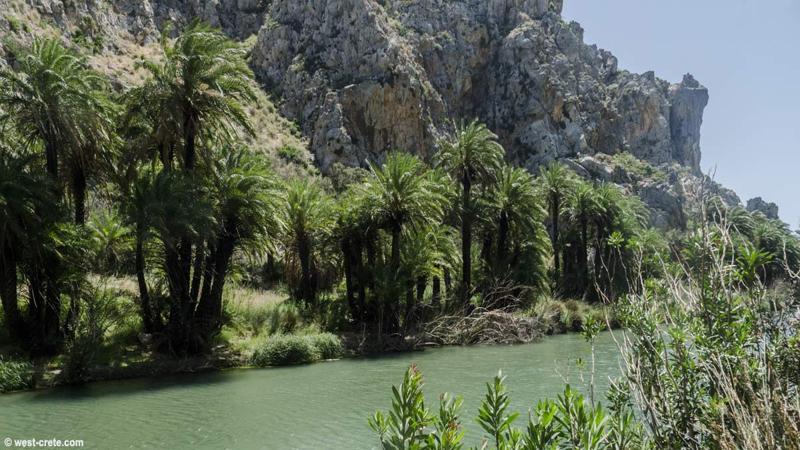

Beach Areas & Swimming Spots
Preveli offers diverse swimming experiences, from the open sea to secluded freshwater pools. Understanding the different areas helps you choose the best spots based on your preferences.
Main Beach
The primary beach area is located where the river meets the sea:
- Mix of sand and small pebbles with some larger rocks
- Approximately 300 meters long but relatively narrow
- Limited natural shade except near the palm trees closest to the river
- Can get crowded during peak season, especially the central section
- The seabed drops off fairly quickly, reaching swimming depth within a few meters
The most popular area is near the river mouth, where you can easily alternate between sea and freshwater swimming. For more space, head to the eastern end of the beach where fewer people venture.
River Swimming
The river offers wonderful alternative swimming spots:
- Main Lagoon - Just before the river meets the sea, it forms a lagoon-like area that's perfect for families with children. The water is calm, clear, and ranges from knee to chest deep.
- Upstream Pools - Walking upstream along the river, you'll discover numerous natural pools of varying sizes and depths. Some are large enough for proper swimming, while others are perfect for sitting and cooling off.
- Small Waterfalls - Several spots along the river feature small waterfalls with pools beneath them, offering natural massage-like experiences.
Sea Conditions
The sea at Preveli can vary significantly based on weather conditions:
- On calm days, the sea is crystal clear with excellent visibility for snorkeling
- When south winds blow, waves can become quite large, making sea swimming challenging
- The eastern part of the beach tends to have slightly calmer waters
- There can be a mild current near the river mouth where freshwater meets the sea
- No lifeguards are present, so exercise appropriate caution
If the sea is rough, focus on river swimming instead. The freshwater pools remain calm regardless of sea conditions.
Temperature Differences
One of the unique experiences at Preveli is feeling the temperature contrast:
- The sea water typically ranges from 22-27°C depending on the season
- The river water stays cooler year-round at approximately 18-22°C
- Where the river meets the sea, you can swim through distinct temperature zones
- This natural temperature variation provides refreshing relief during hot weather
Many visitors enjoy alternating between the warmer sea and cooler river waters for a natural hot-and-cold therapy experience.
Hiking Opportunities
Beyond the beach and palm forest, Preveli offers several hiking opportunities for visitors who want to explore the broader landscape and enjoy spectacular views.
Access Hikes
The two main paths down to Preveli Beach are hiking experiences in themselves:
- Eastern Path (from Kato Monastery)
- Distance: Approximately 1.5 km one way
- Difficulty: Moderate to challenging
- Duration: 15-20 minutes down, 25-30 minutes up
- Features: Dramatic coastal views, glimpses of the palm forest from above
- Terrain: Rocky path with some loose gravel, significant elevation change
- Western Path (from Drimiskiano Amoudi)
- Distance: Approximately 1 km one way
- Difficulty: Moderate
- Duration: 10-15 minutes down, 20-25 minutes up
- Features: Well-maintained path with some stairs, partial shade
- Terrain: Defined path with stone steps in steeper sections
Palm Forest River Trail
Following the river upstream through the palm forest is one of the most rewarding short hikes in the area:
- Distance: Up to 2 km one way (but you can turn back at any point)
- Difficulty: Easy to moderate
- Duration: 1-2 hours round trip, depending on how far you go and swimming stops
- Features: Palm groves, freshwater pools, small waterfalls, wildlife spotting
- Terrain: Varies from sandy riverbank to rocky sections, involves river crossings
There's no formal trail marking, but following the river is straightforward. The path alternates between both banks, requiring occasional river crossings. Water shoes are highly recommended for this exploration.
Preveli Monastery to Beach Loop
For more serious hikers, there's a spectacular circular route connecting the historic Preveli Monastery with the beach:
- Distance: Approximately 7 km full loop
- Difficulty: Challenging
- Duration: 3-4 hours total
- Features: Historic monastery, dramatic gorge views, diverse landscapes
- Terrain: Combination of dirt roads, goat paths, and steep sections
This hike is best undertaken in spring or autumn, avoiding summer heat. It's recommended to start early in the morning from the monastery. Proper hiking boots, plenty of water, and navigation aids (map or GPS) are essential, as parts of the trail are not well-marked.
Coastal Viewpoint Hike
A shorter option with spectacular views:
- From either parking area, follow marked paths to coastal viewpoints
- These short detours (15-30 minutes) offer the best photography vantage points
- The eastern viewpoint provides a panoramic vista of the entire beach, palm forest, and river valley
- Perfect for sunset viewing, though remember you'll need to hike back in diminishing light
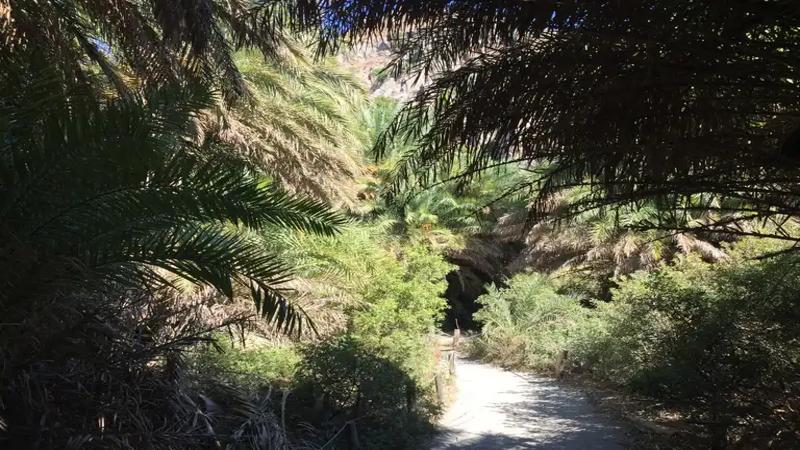
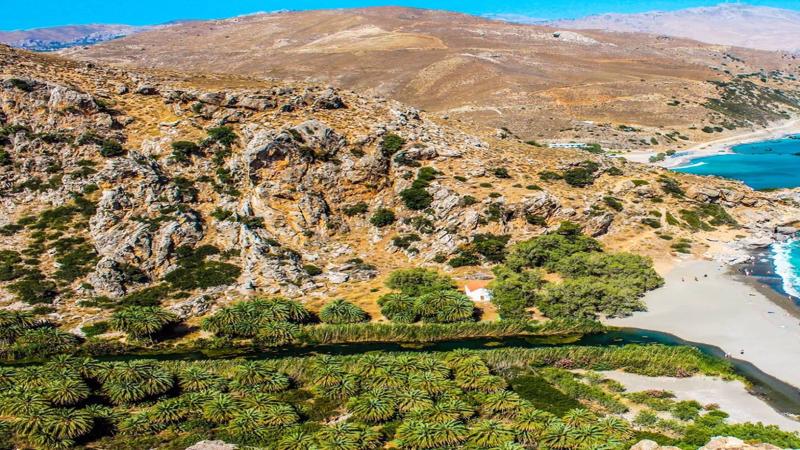
Facilities & Amenities
Preveli Beach maintains a relatively undeveloped character, which contributes to its natural beauty but means facilities are limited. Here's what to expect:
Restrooms
Very limited. Basic facilities at the cantina on the beach. More reliable restrooms at both parking areas.
Food & Drink
Small cantina on the beach selling basic refreshments, snacks, and sandwiches. Operates during summer season.
Sun Beds
Limited number available for rent (€7-10 for two beds and umbrella) on a first-come, first-served basis.
Family Friendly
River pools are great for children, but access paths are challenging for very young kids and strollers.
Shops
No shops on the beach. Small kiosks at parking areas selling basic supplies and souvenirs.
Lifeguards
No lifeguard service available. Swim with caution, especially when sea conditions are rough.
What to Bring
Due to the limited facilities, visitors should come prepared. Essential items include:
- Plenty of water (at least 2 liters per person) - the hike back up is strenuous
- Food and snacks - cantina options are limited and relatively expensive
- Sun protection - hat, sunscreen, sunglasses
- Proper footwear for the hike down/up (not flip-flops)
- Water shoes for exploring the river and protecting feet from rocks
- Cash for parking fees, sun bed rental, and refreshments
- Beach umbrella if you want guaranteed shade
- Snorkeling gear if interested in exploring the sea life
Accessibility Information
Preveli Beach presents significant accessibility challenges:
- The steep paths to the beach are not accessible for wheelchairs or those with serious mobility limitations
- There are no paved paths, ramps, or accessibility infrastructure
- The boat option from Plakias or Agia Galini provides easier access but still requires navigating the beach itself
- The viewpoints from the parking areas are accessible and still offer spectacular views for those who cannot make the descent
If mobility is a concern, consider visiting the more accessible beaches near Plakias or the organized beaches near Rethymno instead.
Parking Facilities
There are two main parking areas serving Preveli Beach:
- Eastern Parking (Kato Monastery side)
- Capacity: Approximately 80-100 cars
- Fee: €2 per day
- Facilities: Basic restrooms, small kiosk selling water and snacks
- Often less crowded than the western parking
- Western Parking (Drimiskiano Amoudi side)
- Capacity: Approximately 50-70 cars
- Fee: €3 per day
- Facilities: Restrooms, cantina with food and drinks, small gift shop
- Generally considered to have the easier access path to the beach
Both parking areas fill up by mid-morning during peak season (July-August). Arriving before 10:00 AM is highly recommended to secure a spot, especially if you have a preference for which access path to use.
Natural Environment & Protected Status
Preveli Beach and its palm forest constitute a unique ecosystem that enjoys protected status and represents one of Crete's most important natural habitats.
Palm Forest Ecosystem
The Phoenix theophrasti palm forest at Preveli is of tremendous ecological significance:
- One of the largest naturally occurring palm forests in Europe
- A relict population that has survived since prehistoric times
- Creates a microhabitat supporting numerous plant and animal species
- Demonstrates remarkable resilience - after a devastating fire in 2010 that burned much of the forest, it has largely regenerated naturally
- The palm species is adapted to both freshwater and slightly brackish conditions where the river meets the sea
These palms reproduce both through seeds (producing small dates) and by sending up new shoots from their root systems, allowing them to form dense groves over time.
Protected Status
The Preveli area enjoys multiple layers of protection:
- Designated as a "Site of Community Importance" under the EU Natura 2000 network
- Protected under Greek forestry laws
- Special conservation status for the Phoenix theophrasti palm, which is listed as a vulnerable species
- Subject to fire prevention measures and restoration efforts after the 2010 fire
Wildlife
The diverse habitats at Preveli support various wildlife:
- Birds - Herons, kingfishers, and various passerines inhabit the river valley
- Fish - The river contains eels and small freshwater fish
- Reptiles - Cretan water snakes (non-venomous), terrapins, and lizards
- Crustaceans - Freshwater crabs can be spotted in the river
- Marine Life - The meeting of fresh and salt water creates interesting conditions for diverse marine species
Early morning and late afternoon are the best times for wildlife observation, when human traffic is lighter and animals are more active.
River Ecosystem
The Kourtaliotiko River that flows through Preveli is one of the few rivers in Crete that maintains year-round water flow:
- Fed by springs in the Kourtaliotiko Gorge and seasonal rainfall
- Creates a green corridor through an otherwise arid landscape
- Supports riparian (riverside) vegetation beyond just the palm trees
- Forms a small but ecologically important estuary where it meets the sea
- Water flow varies seasonally - strongest in winter and spring, reduced in late summer

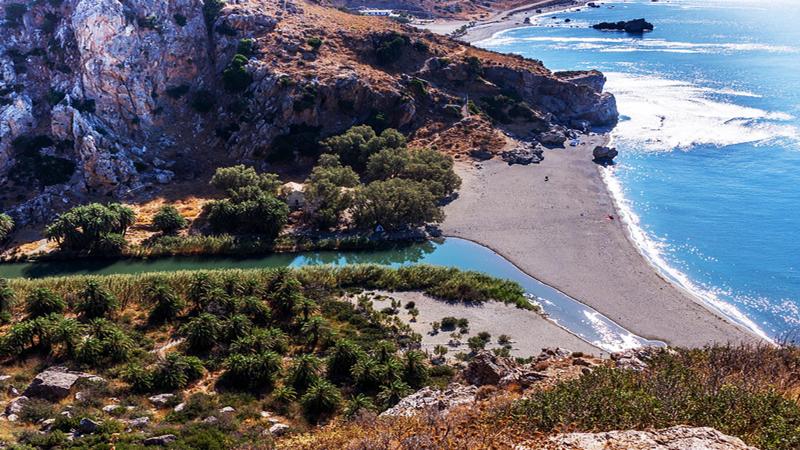
Photo Spots & Photography Tips
Preveli Beach is one of Crete's most photogenic locations, offering stunning compositions that combine tropical palm forest, mountains, freshwater, and sea. Here are the best spots and tips for capturing memorable images.
Top Photo Locations
- Upper Viewpoints - Both access paths have spectacular viewpoints before descending that offer panoramic vistas of the entire beach, river valley, and palm forest. These are perfect for landscape photography and provide the iconic "postcard" shots of Preveli.
- Heart Rock - Near the western viewpoint, there's a naturally heart-shaped rock formation that frames the beach below, creating a unique composition.
- River Meets Sea - The point where the freshwater river flows into the sea creates interesting patterns, color contrasts, and reflects the sky beautifully.
- Palm Canopy - Walking upstream, look for sections where the palms create natural tunnels and canopies over the river for atmospheric shots with filtered light.
- Natural Pools - The clear turquoise pools along the river with palm reflections offer beautiful close-up opportunities.
- Beach Perspective - From the eastern end of the beach looking west, you can capture the dramatic backdrop of cliffs and mountains framing the palm forest.
Photography Tips
Best Lighting Conditions:
- Early Morning (7:00-9:00 AM) - Soft light, calm water for reflections, minimal crowds disturbing compositions
- Golden Hour (1-2 hours before sunset) - Warm light bathes the palm forest and cliffs, creating glowing highlights and dramatic shadows
- Avoid Midday - Harsh overhead light creates strong contrasts that are difficult to capture well, especially with the dark palms against bright sky and water
Technical Considerations:
- A polarizing filter helps manage reflections and enhances the blue and turquoise colors of the water
- A wide-angle lens (16-24mm equivalent) is ideal for capturing the expansive landscape from viewpoints
- A medium zoom lens (24-70mm equivalent) works well for compositions within the palm forest
- Bracketing exposures helps handle the high contrast between bright sky/water and dark palms
- A tripod is useful for low-light conditions or creating silky water effects with longer exposures
Challenging Conditions
Be prepared for some photographic challenges at Preveli:
- High contrast scenes, especially when shooting into the light
- Sand and water environments that pose risks to equipment
- Crowds during peak hours that make clean compositions difficult
- Heat haze during summer days that can affect image sharpness
Consider using a UV filter to protect your lens from sand and salt spray, and bring a microfiber cloth for regular cleaning. A waterproof camera bag or case is highly recommended when exploring the river.
Seasonal Photo Opportunities
Different seasons offer unique photographic possibilities:
- Spring - Lush green palms, stronger flowing river, possible wildflowers on surrounding slopes
- Summer - More defined pools in the river, clearest seawater, dramatic light during golden hour
- Autumn - Pleasant golden light, potential for interesting cloud formations
- Winter - Dramatic skies, powerful river flow, and virtually no other tourists in your shots
Nearby Attractions
Preveli Beach is located in a region rich with natural and cultural attractions. Consider combining your beach visit with these nearby sites to make the most of your day:
Preveli Monastery
Just 3km from the beach parking areas, this historic monastery is well worth a visit:
- Founded in the Middle Ages and rebuilt in its current form during the 17th century
- Played a significant role during WWII, helping Allied soldiers escape from Crete
- Features a small museum with religious artifacts and historical displays
- Offers stunning views from its hillside location
- Opening hours: 9:00 AM - 7:00 PM (summer), 9:00 AM - 5:00 PM (winter)
- Entrance fee: €2.50
- Dress code: Modest clothing required (shoulders and knees covered)
The monastery makes a perfect first stop before heading down to the beach, or a cultural experience afterward.
Kourtaliotiko Gorge
This impressive gorge is the source of the river that flows through Preveli:
- Located approximately 20km north of Preveli Beach
- Dramatic vertical cliffs rising 600 meters high
- Famous for the strange sounds produced by the wind passing through the cliffs (hence the name "Kourtalioti" - "clapping" or "cracking")
- Beautiful springs and waterfalls at the bottom of the gorge
- Access via steps from the main road with viewpoints along the way
Even a brief stop at the gorge viewpoint offers spectacular photo opportunities.
Plakias
This pleasant coastal resort town is about 17km west of Preveli:
- Long sandy beach with water sports facilities
- Variety of restaurants, cafes, and accommodation options
- More developed amenities than Preveli, including ATMs, supermarkets, and pharmacies
- Boat excursions to Preveli and other beaches
- Excellent sunset views from its west-facing tavernas
Plakias provides a convenient base for exploring Preveli and other south coast attractions.
Damnoni & Ammoudi Beaches
Just east of Plakias and about 12km from Preveli are two beautiful beaches:
- Damnoni - Sandy beach with clear water, organized facilities, and water sports
- Ammoudi - Smaller, more intimate cove with turquoise water
- Both beaches offer easier access than Preveli, making them good alternatives for families
- Several excellent tavernas specializing in fresh seafood
These beaches can be paired with Preveli in a "beach-hopping" day tour of the area.
Spili Village
This charming mountain village lies about 30km north of Preveli:
- Famous for its Venetian fountains with lion heads
- Traditional architecture and pleasant village square
- Local shops selling authentic Cretan products
- Excellent tavernas serving mountain specialties
- Cooler temperatures offering relief from summer heat
Spili makes a perfect lunch stop when traveling between Rethymno and Preveli.
Suggested Day Trip Itinerary
For a perfect day exploring Preveli and surrounding highlights:
- 8:00 AM: Depart from Rethymno
- 8:45 AM: Stop at Spili for coffee and to see the famous fountains
- 9:30 AM: Visit Kourtaliotiko Gorge viewpoint
- 10:15 AM: Explore Preveli Monastery
- 11:00 AM: Arrive at Preveli Beach parking (western approach)
- 11:15 AM - 3:30 PM: Enjoy Preveli Beach, palm forest, and river
- 4:00 PM: Drive to Plakias
- 4:30 PM - 6:30 PM: Relaxation time at Plakias beach
- 7:00 PM: Dinner at a seaside taverna in Plakias with sunset views
- 9:00 PM: Return to Rethymno
Frequently Asked Questions About Preveli Beach
Absolutely. While Preveli Beach requires more effort than many other beaches in Crete due to the steep access paths, the unique combination of palm forest, freshwater river, and sea make it one of the most extraordinary landscapes in Europe. Nowhere else on the continent will you find such a well-developed palm forest growing along a river that meets a beautiful beach. The hike down takes approximately 15 minutes and is manageable for anyone in reasonable physical condition. Just prepare appropriately with proper footwear, water, and sun protection.
The western path (from Drimiskiano Amoudi) is generally considered easier and shorter. It takes about 10-15 minutes to descend and includes some constructed steps in the steeper sections. The eastern path (from Kato Monastery) is slightly longer (15-20 minutes down) and has more natural terrain with some loose gravel, but offers more dramatic coastal views along the way. If you have any concerns about mobility, the western approach is recommended. Both paths require good footwear and caution, especially on the ascent back to the parking areas.
While many families do visit Preveli with children, there are some important considerations. The steep access paths are challenging for very young children (under 4-5 years), and impossible with strollers. Parents should be prepared to potentially carry younger children for parts of the descent/ascent. Once at the beach, the river area is excellent for children, with shallow, calm, freshwater pools that are safer than the open sea. If traveling with very young children or those with limited mobility, consider alternative beaches like Plakias or Damnoni which offer easier access while still providing beautiful surroundings.
In August 2010, a devastating wildfire swept through the Preveli palm forest, burning approximately 70% of the Phoenix theophrasti palms. Initially, experts feared permanent damage to this unique ecosystem. However, the Cretan Date Palm has evolved to be surprisingly fire-resistant. Within months, new growth began emerging from the charred trunks and root systems. By 2013, significant recovery was visible, and today (2025), the forest has largely recovered its former glory, though some evidence of the fire can still be seen in the form of blackened older trunks. The remarkable regeneration of this forest has become a success story in Mediterranean conservation efforts.
The temperature difference between the river and sea at Preveli creates one of its unique experiences. The sea typically ranges from 22-27°C (72-81°F) depending on the season, warmest in August and September. The river maintains a consistently cooler temperature of approximately 18-22°C (64-72°F) year-round, fed by mountain springs. The difference is most noticeable during summer months when the sea is warmest. Many visitors enjoy alternating between the refreshing cool river and the warmer sea, especially on hot days. Where the river meets the sea, you can actually swim through temperature gradients, feeling the cooler freshwater floating above the denser saltwater.
There is no accommodation at Preveli Beach itself - the area is a protected natural site with no development directly on the beach or in the immediate surroundings. The closest accommodations can be found in several locations: Plakias (17km) offers the nearest range of hotels, apartments and rooms to rent; the villages of Lefkogeia and Asomatos (10-12km) have a few small guesthouses and villas; and Agia Galini (25km) provides additional options. Many visitors choose to stay in Plakias or Rethymno (35km) and make day trips to Preveli. For a truly unique experience, some visitors camp at nearby official campgrounds and drive to Preveli for the day.
During July and August, particularly between 11:00 AM and 4:00 PM, Preveli Beach can become quite crowded. The main beach area near the river mouth receives the heaviest traffic, especially when tour boats arrive from Plakias and Agia Galini (typically dropping visitors for 2-3 hour stays). However, even during peak season, you can find more secluded spots by walking further upstream along the river or toward the eastern end of the beach. For a more peaceful experience, visit in May, June, September or October when the beach has significantly fewer visitors while still offering excellent weather conditions. Alternatively, arrive very early (before 10:00 AM) or later in the afternoon (after 4:00 PM) when day-trippers have departed.
While Preveli Beach is not officially designated as a nudist beach, some discreet nudism occurs in the more isolated eastern sections of the beach, away from the main river mouth area and palm forest where most visitors congregate. The main beach areas and river are considered family-friendly, and nudism is not appropriate in these zones. If you're specifically looking for recognized nudist beaches, Plakias has a designated section at its eastern end, and there are several other officially naturist-friendly beaches along Crete's south coast that offer better facilities and acceptance for this practice.
Why Rent a Car for Your Preveli Beach Visit
Having your own rental car is by far the best way to experience Preveli Beach and explore the surrounding area. Here's why:
- Flexibility to visit early morning or late afternoon to avoid crowds
- Freedom to stay as long as you want without transportation schedules
- Ability to visit both access paths and choose your preferred route
- Combine Preveli with Preveli Monastery, Kourtaliotiko Gorge, and Plakias in one day
- Storage for extra clothes, towels, and supplies in a secure location
- Air conditioning for comfort after the hot hike back up from the beach
- Access to more remote viewpoints not covered by public transportation
- Save on taxi costs which can be substantial in rural areas
- Visit local villages and authentic tavernas along the way
- No need to coordinate with boat schedules or tour departures
At Fast and Easy Rent a Car Crete, we offer:
- Unlimited mileage on all rentals
- No security deposit required
- Free additional driver
- 24/7 roadside assistance
- Comprehensive insurance options
- New, well-maintained vehicles
- Free cancellation up to 48 hours before pickup
Explore More of Southern Crete
Preveli Beach is just one highlight in our comprehensive 8-day Crete itinerary. Discover more stunning beaches, dramatic gorges, and authentic experiences with our detailed self-drive tour plan.
View Our Complete Crete ItineraryNeed Assistance Planning Your Preveli Visit?
Our local team knows Crete inside out and can help you plan the perfect itinerary that includes Preveli Beach and other nearby attractions. Contact us for personalized recommendations and special car rental offers.
